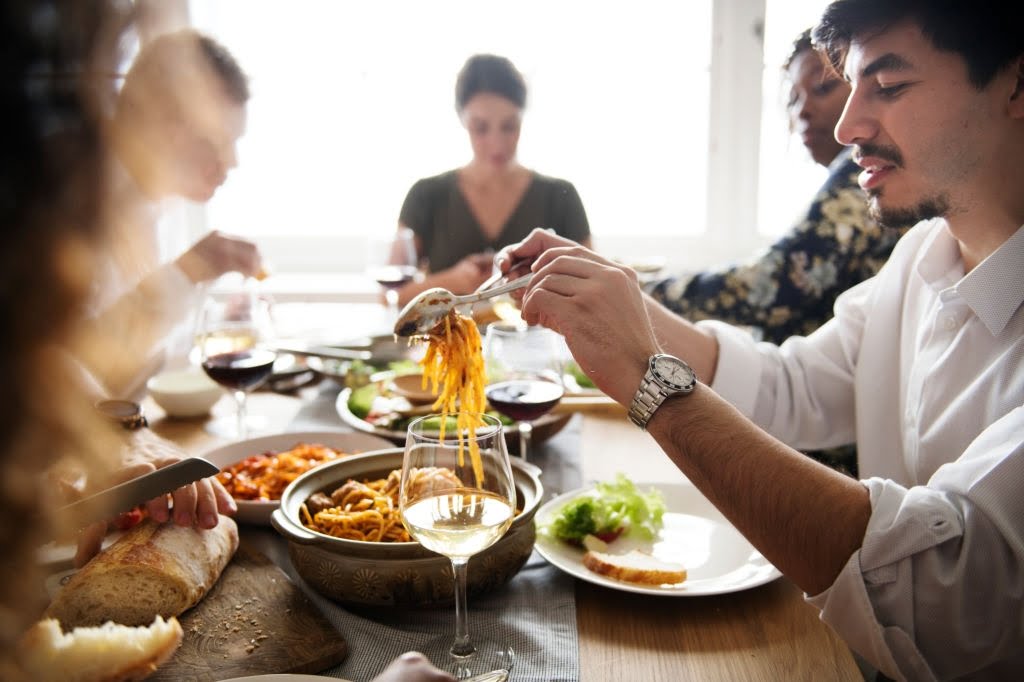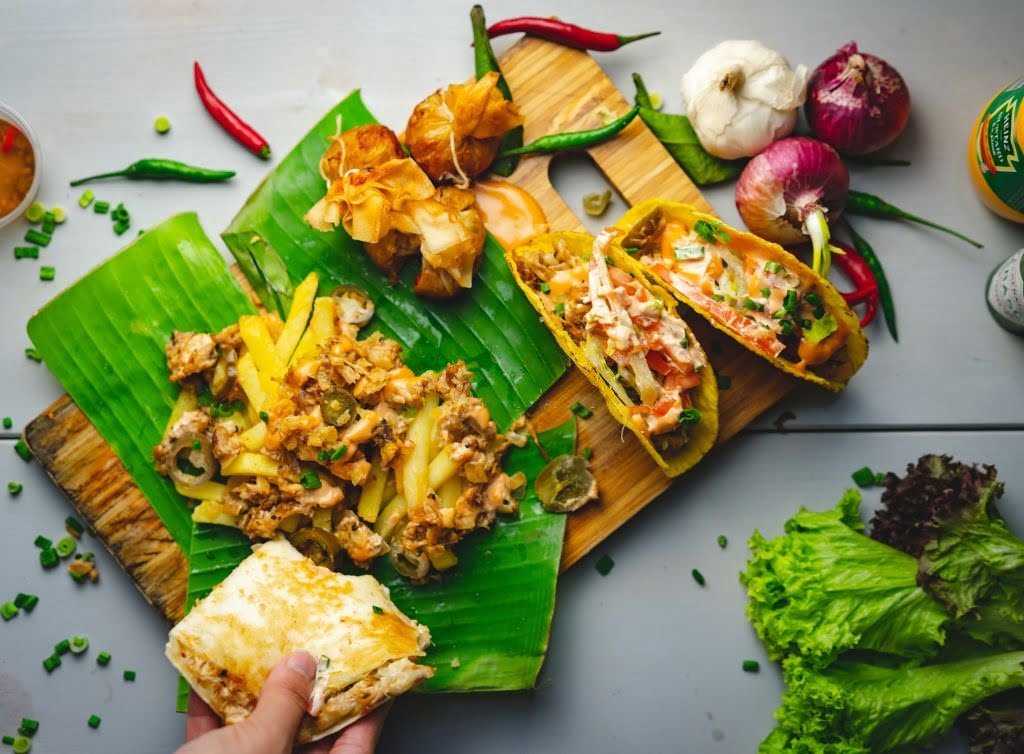How Culture Defines Who You Are: The Italian-American Lifestyle

There is usually a clear picture that comes to mind when someone is telling a story about an Italian person. Italian-Americans have a certain way about them that makes them completely identifiable with no trouble. This paper discusses the impact that one’s culture and ethnic background has on how they do just about everything in life, especially those of Italian descent. The paper expands on the way that this culture has the power to influence the way that a person constructs their entire persona, their beliefs, way of speaking, appearance, etc. and additionally, the role of stereotypes.
You are probably imagining a big white dude in a track suit with greased up hair freshly gelled, a giant crucifix and chain laying on a slightly visible hairy chest, probably driving a white escalade. Yeah me too. But it’s not all guinea tee’s and meatballs when it comes to being a proud Italian-American. I’m what you might call a “mutt” in the sense that I am a person of many ethnicities, (French, Spanish, Irish, German, Italian, just to name a few). Both my parents were born and raised here, along with both of their parents, and yea their parents too. So, my great-great grandpa was actually born in Naples, Italy, and that’s where I get my Italian from. In short, I’m pretty Americanized. Though this holds true I have always been interested in my Italian roots. I love the food, the accents, the artwork, and I’m a fan of the stereotypes at times too. That is why I’ve decided to do some digging to find out how this one thing about a person such as their heritage and culture, can define someone and dictate how he or she lives their life. The Italian-American culture is a perfect place to start, because it’s so well-known and the people have historically had great success here in America. It is very interesting to think about how humans behave, why they do things, their reasons for their beliefs, so when you think about this through an ethnic lens it’s even more compelling.
An Italian person is someone that can be very identifiable in this day and age. From the moment immigrants settled in America, they spread their lifestyles and customs while simultaneously adapting to life in this new environment. Italians have found their place in America through hard work and tenacity, and have had massive success in many different areas. Generations have passed down their beliefs and creative genes to make what is now the Italian-American. Americanized children of Italian descent have had a very different life compared to their older generations. It is not hard to find people of Italian blood who have never even been to Italy. These facts pose the need for research. The need to find out how throughout the growing generations, how is one’s culture still able to define who one is?
Italian culture can very well be synonymous with food. To Italians, food is all about family. It brings people to the table, breaking bread with one another, and keeps the family connected, and the traditions alive (Fellin 2014). One thing that comes with food is authenticity. This is something that many food connoisseurs search for when choosing where to eat. For instance, Olive Garden is a popular restaurant food chain with businesses set up around the nation. The food, friendly staff, and family like atmosphere are all things that make customers return because of the general feeling that this place gives them. They are fooled into thinking that this place is authentically Italian even though in reality this place makes real Italians gag. The marketing strategy that this restaurant, and many others use exploits Italian culture making it a go to place for people who know no better to have an “Italian dinner” (Cinotto 2001).
Part of someone’s identity includes the exact region they are from. For Italians this is a huge deal. Many times, you’ll hear someone say, “Are you Italian?” To which they’ll reply, “No I’m Sicilian.” Though confusing to some, the town one is from is a big part of their identity as Italian-Americans. Because of this, there are certain feelings towards each town within Italy. Senseless hate or jealousy arises because the “my people are better than your people,” argument comes into play (Luconi 2011).
Pop culture and media are important elements that effect the way people define who they are and the way they behave. It is human nature to take the opinions of other people, sometimes even strangers into consideration when it comes to your own life. Celebrities like Tony Bennett, Lady Gaga, and Robert De Niro are just some of many Italians who have had impressive success stories in America and abroad. Italians have had a huge impact on the American Culture in every aspect (Luconi 2014). With all the good that has come from Italians in America, also comes all of the misconceptions. Stereotypes have been around in every culture for many years. There’s almost no getting away from them. For a long while, the “Italians are gangsters” stereotype has been one, if not the most prominent one of them all. It is the first thing that comes to mind when thinking of Italian-American Stereotypes. It being centerstage in the minds of the public, has taken attention away from all the other false stereotypes that could be debunked (Cavallero 2004).
In order to conduct my research, several sit-down interviews were held with a number of different people of different ages and stages of life. I felt this was the best way to get as much specific and authentic information possible, rather than relying solely on articles and books. I interviewed a total of 6 people including 5 females and 1 male. All but one was of Italian descent, and all but 2 have been to Italy before. The people I interviewed were, Kellie Nicoll, Gabriella Cammarata, Sam Salvatore, Gina Beneduce, Lauren Armada, and John Hannan. Kellie, Lauren, and John were all 21 years old college students while Gabby was 18, the youngest of the bunch. Sam was 29, a physical education teacher at an elementary school and Gina, a 45-year-old who also works at an elementary school. All of these people live completely different lives but share one thing, their connections to Italy. I chose to include Lauren, whose parents were born in the Philippines, and are not Italian because she was one of the subjects who had been to Italy and she offered a lot of insight on the culture that she had experienced.
The interviews were conducted in person, and over the phone, with me recording them through my phone to collect the data. Each interview varied in time, but averaged about 15 minutes per interview. I asked them all the same eight questions which I personally crafted with the intention on getting as much accurate and relevant information geared towards my subject of research as possible. The goal of these interviews was to be able to analyze each individual’s differing experiences and take what I’ve learned and apply it to my main research questions. Each interviewee gave me consent to use their name and share their answers for my research purposes. In addition, my research also includes several pieces of my own experience as an Italian-American woman who grew up in the United States.
When Italians packed up their lives and began to start a new in America, they brought over their ways of life and abundance of traditions. When assimilating to life in the new land, new habits and customs began to intertwine with that of the old ones. Through years of developing this hybrid lifestyle, the Italian-American identity was born. Now, any native Italian will tell you that things are a little different back in the old country. This is indeed true, but with all the differences you will still find that the root of the differences comes from the mother land.
One of my interviewees, and also cousin Gabriella Cammarata is a freshman at the University of Delaware and got to spend her first semester abroad in Italy. Through culture shock, she got to learn first-hand how life actually is in Italy, contrary to some Italian-Americans beliefs. Gabby often speaks about how this was the greatest experience of her life, and how much it has shaped her as a person. She describes the country as, “a whole other world over there.” She found that in America, it’s eat, sleep, work, repeat. But over in Italy, it’s all about leisure and living your best life. According to her, Italians don’t seem to wake up earlier than 9 AM. “Everyone in Italy is so friendly and loving, its not weird for you to kiss others hello, be affectionate, and relate to strangers.” This factor right here, is hard to come by in the states, especially in New York. Gabby isn’t the only interviewee that felt this way. Interviewee Gina Beneduce, described her experience in Italy as “an amazing experience. The buildings and architecture were breathtaking, and the people were more friendly than I was used to.” A mother of 3 from Brooklyn, Gina grew up in a home that valued the Italian-American way of life. Her grandparents were born in Italy and parents adopted traditions and beliefs from them.
In addition to Gabby and Gina, another interviewee and Italian-American, John Hannan gave us some more insight on how the Italian-American differs from the native Italian. In 2014 he visited Rome, Florence, and Venice, with day stops in Assisi and Padua. “The average Italian is quite different from the average Italian-American,” says Hannan. “Everyone smokes a lot more, but beyond that everyone seems healthier. I’ve also found that a lot of Italian-Americans are the real ‘Law-and-order’ types in our modern climate, whereas there’s a real culture around ‘screw the rules I do what I want’ over there.” This is a common analysis of “the real vs. the fake” Italians. The attitudes of both types of people differ and it is a noticeable trait.
With personality differences, comes other differences. In addition to all of these differences, one major one between Italians and Italian-Americans is their food. Food is what connects people in any culture, but for Italians it is everything. It is a major part in their identity. Whether it’s discussing, preparing, or eating the food, it’s all about being together for this culture (Fellin 2014). Yes, it is true, Italian food is a gift bestowed upon us from the food gods themselves. However, your favorite “Italian” dish might not be as Italian as you think. For example, chicken parmesan. A delicious fried chicken cutlet smothered in mozzarella, doused in the coveted marinara sauce, served over a bed of fresh spaghetti, will not be found on any menu in Italy. The same thing goes with Fettuccine Alfredo, Spaghetti and Meatballs, Bolognese, the list goes on and on. These are all Americanized dishes which you’ll find being done in every culture. Americans take ideas and expand on them until its normalized and given the title, “Italian food.”
Another thing about the old country is that their portions of food are far smaller than in America. The next interviewee, Lauren Armada visited Italy last spring and was disappointed with the food there. Lauren is one of my best friends since high school, and let me tell you, we eat a lot. We are frequent flyers at all the best restaurants in Staten Island and NYC, so when I heard she was going to Italy I was psyched to hear about the food excursions. I was stunned to hear that she wasn’t all that impressed with the food there for a couple of reasons. Number one, she was always hungry when she left an eatery, and number two, they didn’t have some of her “Italian” favorites on the menus. This was a crushing blow to hungry me but an interesting experience to hear about. This just shows you clear as day just how much the food differs between Italians and Italian-Americans.
Moving away from the differences, there are a ton of similarities between Italians and Italian-Americans. One of these is traditions. Passed down from older generations religious events like Christmas Eve and Easter are big family gathering days for everyone that is Italian. More often than not, the stereotype “Italians have big families” holds a lot of truth. Families and extended families get together during these times at someone’s house and they feast on fish, meats, and of course pasta! For instance, interviewee Kellie Nicoll enjoys Easter the most because her Dad makes the dish called “Pizza Rustica.” Another common tradition is Sunday dinners. All but one of my interviewees say that they participate in this tradition. It is when a bunch of family comes over to enjoy a big Italian meal usually involving “Sunday sauce.” Interviewee Sam Salvatore is a big fan of this tradition stating that “it’s the best day of the week.” All of these similarities, differences, ways of life, and traditions are what creates the Italian-American identity.
Italian-American people are some of the most proud and patriotic groups of people there are. More often than not, they tend to heavily identify with their culture and heritage. Breaking it down even further, Italians may take even more pride in the region of Italy in which they are from. In fact, when immigrants first settled in the States, they would separate and live where relatives and those from their towns back home have settled. For example, people of Lombardia held prejudice against people of Toscana, and all of them didn’t like the people from Sicilia. Each one felt they were somehow better than the other. This practice is what helped form the Little Italy’s of the nation (Luconi 2011). Through time, all of these petty grudges and feelings got thinner and thinner and we as people have realized that we are all the same, Italians! When I asked my interviewees what it means to them to be Italian, almost every one of them had the word “pride” in their answer. “To be Italian means strong family ties, home cooked meals, pride, and repping the best,” interviewee Cammarata says. I have found that the word pride has a very strong and impactful meaning to Italian people. “Being Italian means pride in my heritage and really good Sunday dinners,” interviewee Salvatore responds. One very common way of this group of people showing pride is their material things. Many people choose to dress and style their hair a particular way that reflects their older family members which then reflects to those from the old country. The same thing goes with jewelry. Many Italian-Americans show off big crucifix pendants along with Saints and other religious mementos, as it is customary for Italians to be religious and spiritual. Some Italians also show off their pride as far as in their vehicles. I can’t tell you how many Cadillacs I see whenever I leave my house, (Staten Island is highly populated with Italians). Often times, you may see the tri-color Italian flag take some form inside or outside folks’ vehicles, homes, clothing, accessories, you name it.
Media and Pop Culture
Italians are rich with culture. From music, to food, cinema to literature, Italians have made a huge impact in how we as Americans enjoy life (Luconi 2014). Now more than ever, media and pop culture play a huge role in increasing the interest in one’s own culture and ethnic background. This holds true especially for those of Italian descent. Italians are no strangers to the world of film and television. You are probably familiar with films such as Goodfellas, The Godfather Trilogy, A Bronx Tale, and even television shows like The Sopranos. What do these films all have in common? They are gangster films. These types of films showcase the stereotype that all Italians are in the mafia to the furthest degree. For a while, this was the sole stereotype, or one that stuck out the most when thinking of Italians. It overshadowed all other stereotypes which allowed for the others to go uncurbed (Cavallero 2004). These types of works all feature the lives of several different Italians and Italian-Americans in ways that are relatable but at the same time exaggerated. There is something about watching cool guys on the big screen live life on the edge that makes you want to be them. Italians in films are almost always portrayed in a positive and appealing light, even when they are the bad guys. The way these characters walk, talk, act, and dress makes viewers want to be them. When seeing all these elements combined with the fact that the characters are Italian, makes viewers that are also Italian relate and feel a connection to these characters on the screen. This in turn, makes Italian-Americans even more interested in their heritage.
Time and time again, social media is one outlet that proves to influence people one way or another. There are so many celebrities and social media influencers using popular sites such as Instagram, Twitter, YouTube, etc. They are unique in that they are platforms that allow for the direct interaction between celebrity and fan. With this being said, there are so many Italian and Italian-American celebrities and influencers who play a big part in the public perception of Italian people as a whole. Some people even base their entire careers off of the simple fact that they are Italian. Take the comedian Sebastian Maniscalco for example. With 777K followers on Instagram, multiple comedy specials on Netflix, and a couple of movies under his belt, he has a lot of eyes on him constantly. His whole persona is based off of the fact that he is Italian. In his shows he always discusses his family life, growing up with immigrant parents in Chicago. Most of his fans are of Italian descent while there are still those that are not, who tune in to laugh at his Italian based humor. In his comedy special, “Aren’t You Embarrassed,” he jokes about having a Passover meal with his Jewish wife. He begins to paint the picture of them sitting down at 7:30, and him being starving. They start passing around reading material, and he asks why. His wife goes, “We read for two hours before we eat.” He then makes the joke that he is Italian and if he doesn’t have bread within 15 seconds of sitting down, he’s going to lose it. This is just one example of how relatable he is to Italian people. His personality and charismatic ways make him a very likable guy, which makes him a powerful influencer. With this proving true, it is very common for his Italian audience to want to be more in touch with their heritage after watching his performances.
Another example of how social media influences people’s behavior and lifestyle choices, is TikTok. This is a newer platform that continues to increase in popularity and features quick snips of videos usually accompanied by music or a “sound.” Like every other social media site out there, there is a space for Italians who use their ethnicity to make funny Italian-based jokes on their videos. One popular creator on the site is Sean Havens. Like Sebastian Maniscalco, he also bases his whole persona off of the fact that he is Italian. His fans tune in to watch him and his grandmother make her homemade Italian dishes while also trying to stuff him with food until he explodes. A lot of Italian-American jokes are made and his whole aura is what makes him so relatable and is what keeps people watching. Like these other public figures, he generates an interest for people to get more in touch with their Italian roots. People begin to look up to these influencers and in turn imitate their behavior.
In addition to these movie stars and social media influencers, stereotypes play a major role in how the media and pop culture increases the interest in one’s own identity. We can’t talk about stereotypes without mentioning the Jersey Shore. This show is the perfect example of how stereotypes influence people’s behavior. For example, as shown immediately being introduced on the show, Pauly D lives through common stereotypes such as being constantly tan, perfectly crafting his hair each day, always having nice clothes on, constantly wearing jewelry, and of course having many Italian themed tattoos. One of those tattoos include the word “Cadillac” in giant script letters down the side of his torso. He is pretty much the prime example of a walking stereotype. Like Pauly D, his cast members are all very similar in their beliefs and appearance. This show was a massive success which even got a reboot that is still active today. One of the major reasons this show did so well was because of the connection to their Italian heritages. Fans watch the behaviors of the cast and want to be just like them. That’s where you see a lot of copy cats throughout the country dressing and acting like these reality TV stars. Whether you love them or hate them, you’re still talking about them, and that’s why these types of shows have so much power. Stereotypes, whether true or not effect how people behave and choose to live their life.
There are plenty of stereotypes other than what is seen on the Jersey Shore. One example is that all Italians talk with their hands. In a lot of cases, this proves to be true. One of my afore mentioned interviewees, Gabriella Cammarata, shed some light on the subject of stereotypes. She shared her views on numerous stereotypes such as the “talking with their hands” one. She feels that although this one holds some truth; she is not a fan of it because she feels like she is being mocked when people bring it up to her. Another stereotype she found to be true for her was that Italians always have good food in the house. “My house was always deemed the snack house or the house with the most food growing up. There is usually a lot of meat and cheese in our fridge.” She also went on to share about how her holidays are. “Holidays are out of control, and it takes a lot to get the women in charge to sit.” I can back this one up because I’m always there for those holidays. So yes, what you’ve heard about Italians and their families on holidays, is a very true stereotype. Stereotypes can have a lot of influence on people as a whole. One influence can be seen at places like restaurant chains. For instance, when you walk into an Olive Garden, the sights, sounds, and smells could take you back to a familiar place. Seeing all the happy faces in the dinning room enjoying their favorite dishes, with the company of family and friends can make you remember good times at a relative’s house for Sunday dinner. The décor, furniture, table settings, and everything else that makes Olive Garden, Olive Garden is all done for a specific purpose. It is a strategic marketing approach that is intended to make customers feel at home and surrounded by family. This strategy is inspired by traditions of Italian and Italian-American culture and is why people are under the assumption that it is “authentic.” (Cinotto 2001, Page 245)
Therefore, it is now clear that one’s culture does indeed greatly impact the way one lives their day to day life. Your culture defines who you are, what you stand for, and how you present yourself to the word around you. Everyone is different in this life, especially here in America. Our differences are what makes this place so special. They unite us. One day you may find yourself down in the dumps, with not a penny to your name. But one thing you’ll always have is your roots. Where you are from, who came before you, the genes they have given you, these things are things you take with you wherever you go, and they will never go away. It is something you are born with, and something you can’t change. Your culture is what makes you unique, what makes you, you
References
Cavallero, Jonathan J., and George Plasketes. “Gangsters,Fessos, Tricksters, and Sopranos: The Historical Roots of Italian American Stereotype Anxiety.” Journal of Popular Film and Television, vol. 32, no. 2, 2004, pp. 50–73
Cinotto, Simone. Making Italian America: Consumer Culture and the Production of Ethnic Identities. Fordham University Press, 2014.
Fellin, Luciana. “The Italian New Wave: Identity Work and Socialization Practices in a Community of New Italian Immigrants in America.” Forum Italicum: A Journal of Italian Studies, vol. 48, no. 2, 2014, pp. 292–310
Luconi, Stefano. “Discrimination and Identity Construction: The Case of Italian Immigrants and Their Offspring in the USA.” Journal of Intercultural Studies, vol. 32, no. 3, 2011, pp. 293–307
Luconi, Stefano. “Italian Americans.” Multicultural America a Multimedia Encyclopedia, by Cortés Carlos E. and Jane Sloan, Sage Publ., 2013, pp. 1247–1250.







Responses